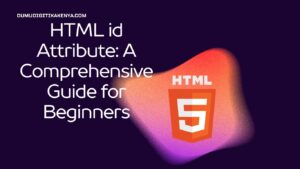Introduction To HTML Input Attributes
In the dynamic realm of web development, understanding the power of HTML Input Attributes is like unlocking the gateway to crafting intuitive and user-friendly web forms. HTML (Hypertext Markup Language) Input Attributes are the secret sauce behind form elements that enable users to input, submit, and interact with data effortlessly. Whether you’re a novice web developer embarking on your coding journey or a seasoned pro looking to refine your skills, this comprehensive guide is your compass to demystifying HTML Input Attributes. In this article, we’ll delve deep into these attributes, unraveling their diverse capabilities, and providing hands-on examples that empower you to build effective and engaging web forms. So, fasten your seatbelt, as we embark on a journey to harness the potential of HTML Input Attributes for creating web forms that not only capture data but also deliver a stellar user experience.
As we navigate through this guide, we’ll explore fundamental HTML Input Attributes such as ‘type,’ ‘name,’ ‘id,’ ‘value,’ ‘placeholder,’ and ‘required.’ Each of these attributes plays a pivotal role in shaping the behavior and appearance of form elements, enabling you to tailor your web forms to your exact specifications. Whether you’re creating a basic text input field, password input, radio buttons, checkboxes, or crafting a submit button, understanding how to wield these attributes effectively is paramount. By the end of this article, you’ll not only grasp the mechanics of HTML Input Attributes but also be equipped to design web forms that seamlessly capture user input, ensuring your websites engage and interact with visitors at an entirely new level. So, let’s dive deep into the world of HTML Input Attributes, starting with the basics and working our way towards mastery.

Table of Contents
Prerequisites
Before we get started, you should have a basic understanding of HTML. If you’re completely new to HTML, I recommend learning the basics of HTML tags and structure first.
HTML Input Element
The <input> element is used to create form controls that allow users to input data. It has several attributes that define its behavior, appearance, and functionality. Let’s explore some of the most commonly used input attributes:
- Type Attribute The
typeattribute specifies the type of input control you want to create. It can take various values, each serving a specific purpose.
- Text Input: This is the default type. It creates a single-line text input field.
<input type="text" id="username" name="username"> - Password Input: Use this type to create a password input field where the characters are masked.
<input type="password" id="password" name="password"> - Checkbox Input: Creates a checkbox for multiple-choice options.
<input type="checkbox" id="subscribe" name="subscribe" value="yes"> - Radio Input: Used for exclusive choices in a group.
<input type="radio" id="male" name="gender" value="male"> <input type="radio" id="female" name="gender" value="female"> - Submit Button: Generates a submit button for form submission.
<input type="submit" value="Submit">
- Name Attribute The
nameattribute specifies the name of the input element. It’s crucial for form processing on the server-side, as the input’s value is sent using this name as an identifier. - ID Attribute The
idattribute provides a unique identifier for the input element. It’s helpful for targeting the element with JavaScript and CSS. - Value Attribute The
valueattribute defines the initial value of the input field. For text inputs, it sets the default text. For checkboxes and radio buttons, it determines the initial state. - Placeholder Attribute The
placeholderattribute is used to provide a hint or example text within the input field. It disappears when the user starts typing. - Required Attribute Adding the
requiredattribute makes the input field mandatory, ensuring that users must fill it out before submitting the form.
<input type="text" id="email" name="email" required>Sample Code and Output
Let’s put these attributes into practice with a simple HTML form:
<!DOCTYPE html>
<html>
<head>
<title>Sample Form</title>
</head>
<body>
<h1>Contact Us</h1>
<form>
<label for="name">Name:</label>
<input type="text" id="name" name="name" placeholder="John Doe" required><br>
<label for="email">Email:</label>
<input type="email" id="email" name="email" placeholder="john@example.com" required><br>
<label>Gender:</label>
<input type="radio" id="male" name="gender" value="male"> Male
<input type="radio" id="female" name="gender" value="female"> Female<br>
<label for="subscribe">Subscribe to newsletter:</label>
<input type="checkbox" id="subscribe" name="subscribe" value="yes"><br>
<input type="submit" value="Submit">
</form>
</body>
</html>Explanation
- We created a simple form with text inputs for Name and Email, radio buttons for Gender, and a checkbox for the newsletter subscription.
- The
forattribute in<label>elements is used to associate labels with their corresponding input elements. This enhances accessibility and user experience. - We added the
placeholderattribute to provide helpful hints for the Name and Email fields. - For Gender, we used two radio buttons with the same
nameattribute to ensure exclusive selection. - The “Subscribe to newsletter” checkbox allows users to opt in.
- Finally, we included a Submit button for form submission.
Conclusion
In closing, our exploration of HTML Input Attributes has illuminated the path to crafting web forms that are both functional and user-centric. These attributes serve as the foundation upon which user interactions are built, allowing developers to create forms that cater to diverse needs. From text inputs that capture names and emails to radio buttons that offer exclusive choices, HTML Input Attributes empower web developers to create seamless and interactive experiences. Moreover, the knowledge gained here opens doors to endless possibilities for enhancing web forms, making them more accessible, engaging, and ultimately effective.
As you continue your journey in web development, remember that HTML Input Attributes are just one piece of the larger puzzle. By mastering these attributes, you’ve taken a significant step toward becoming a proficient web developer. Stay curious, keep learning, and explore other aspects of HTML and web development to unleash your full creative potential. With HTML Input Attributes as a solid foundation, you’re well on your way to crafting web forms that not only capture data but also provide exceptional user experiences. So, go forth, code with confidence, and watch your web forms come to life!




